 Equal Housing Lender. Bank NMLS #381076. Member FDIC.
Equal Housing Lender. Bank NMLS #381076. Member FDIC.
 Equal Housing Lender. Bank NMLS #381076. Member FDIC.
Equal Housing Lender. Bank NMLS #381076. Member FDIC.
May 2, 2022—Inflation risk is to the downside for the first time in more than a year and the Federal Reserve (Fed) is likely to hike less than the current market pricing of 10 more hikes (+2.5%) this year. Price pressures were already set to ebb of their own accord even before the Fed set out on a path to tighten financial conditions. The Fed has only hiked once, by 0.25%, but its communication of expected future hikes has pushed up Treasury yields and mortgage rates at unprecedented paces, which will act quickly to bring down inflation. Indeed, we’re already seeing evidence in the housing market. We expect inflation to slow to 4.5% by December 2022 (Figure 1) on its way to slower rates in early 2023.
What does it mean for the Fed and markets?
We think the Fed is likely to remain on its hawkish path in the near term, taking the opportunity to hike by 0.5% at its May 4 meeting, and possibly again in June. As we move into the second half of 2022 the deceleration will become clearer. That would lead the Fed to dial back expectations of rate hikes and balance sheet normalization relative to current expectations. By itself, lowering the rate hike path would likely be supportive of risk assets, but as we recently wrote, the Fed is not the only risk to equity performance. There is also a commodity price spike resulting from Russia’s war on Ukraine and flagging consumer sentiment. More recently, lockdowns in China to stop the spread of COVID-19 have emerged as a threat to growth. While there are many reasons to expect inflation to slow, we remain quite humble regarding baseline forecasts in these uncharted waters. We recognize there are notable upside risks for inflation too.
Figure 1: Consumer price index inflation and forecast (% y/y)
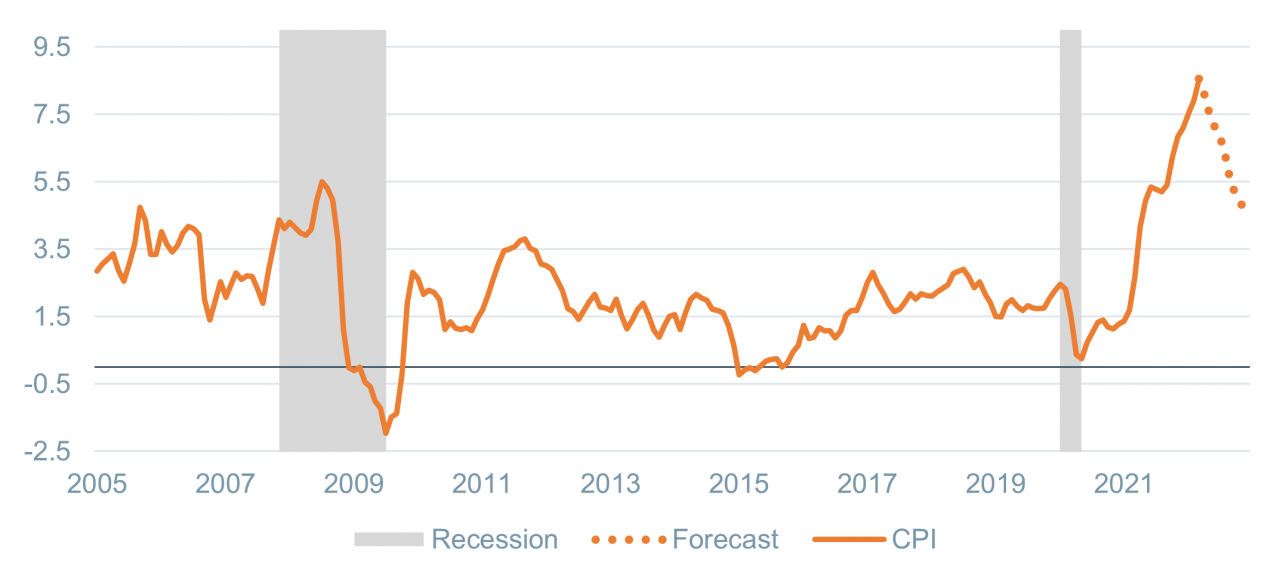
Data as of March 31, 2022. Sources: Bureau of Labor Statistics, Wilmington Trust.
The state of play—Decelerating core inflation
Let’s start with a description of what has happened. In March, consumers faced a 40-year high in inflation with the consumer price index (CPI) jumping 1.2% in a single month (not shown) and hitting 8.5% year over year (y/y), the highest since December 1981 (Figure 1). Much of that increase was in energy prices stemming from the war in Ukraine and from food prices.
Digging further into the rest of the proverbial “consumer basket” tells a different story. Figure 2 shows month-over-month (m/m) changes in so-called core CPI, which includes all components except for food and energy. (Economists get a bad rap for looking at core inflation, as though we don’t think food and energy costs are important. On the contrary, they are incredibly important, but also volatile, and core measures are shown to be better at detecting underlying inflation trends.)
The figure shows both the understandable concern about high inflation but also the recent deceleration. From 2015 to 2019 the average m/m advance was 0.17%. The sharp bursts in April, May, and June 2021 were roughly five times the norm and were unsettling. As was well-documented at the time, those bursts were driven by a handful of tiny categories that surged during the reopening. And yes, I’ll use the dirty word “transitory” (which has unfortunately disappeared from the lexicon) to describe that initial burst.
Figure 2: Core consumer price index (CPI) and component contributions (% m/m)
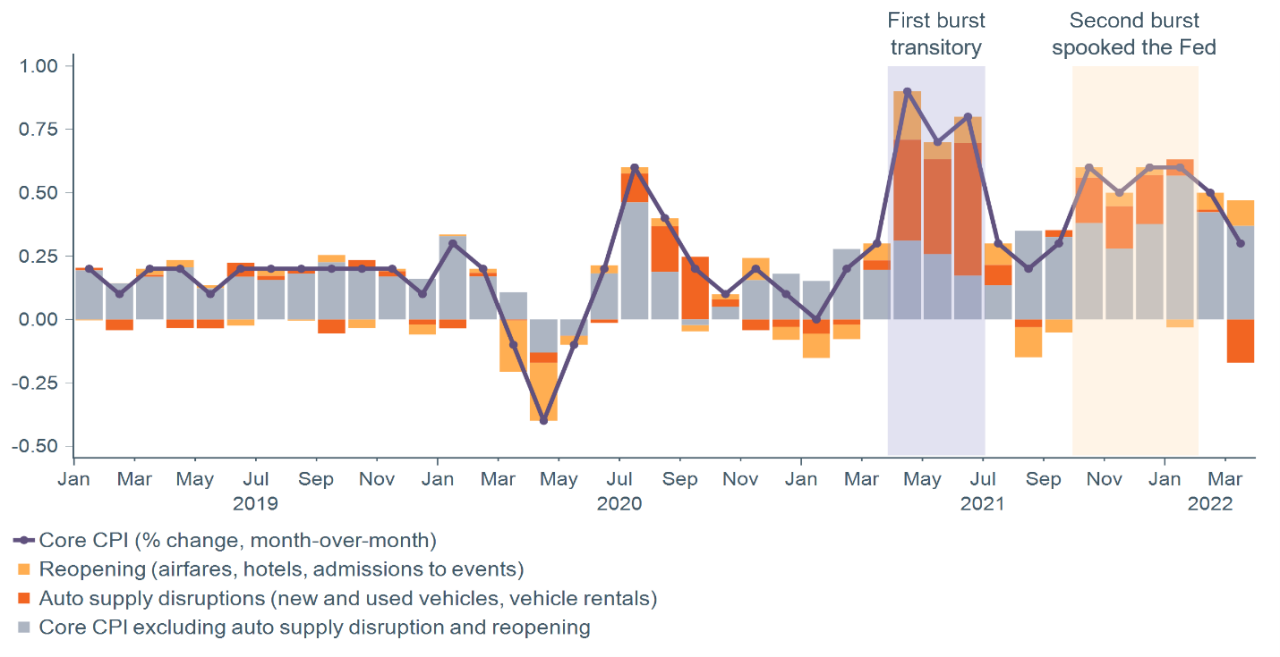
Data as of March 31, 2022. Sources: WTIA, Bureau of Labor Statistics, Macrobond.
Broad-based inflation starting to slow
It was the second burst of inflation from October 2021 to January 2022 that spooked the Fed moving it quickly to its hawkish stance. Though lower in magnitude than the earlier episode, inflation at the end of 2021 was more broad-based across categories and was paired with an unemployment rate that fell from 5.9% in June 2021 to just 3.9% in December along with surging wages. That combo reeked of well-entrenched inflation, the kind that might result from too much money being dumped into a strong economy by fiscal and monetary authorities, which sloshes back and forth between higher prices and higher wages.
Core CPI advanced just 0.3% in March. That figure, while still elevated compared to norms, is encouraging. And while a single data point does not make a trend, there are many signs that price pressure is abating and several reasons to expect the deceleration to continue.
The slowing consumer
The key is the consumer. Last year’s inflation surge was brought on by unprecedented spending on physical goods, which was reflected in retail sales. Figure 3 shows that massive surge; looking past the base effects of the shutdown months you can see year-over-year growth running 15%–20% higher in 2021. As of March 2022, it dropped to 7%. Relief is setting in.
In 2021, businesses experienced surging cost pressures and strong demand. They passed on whatever cost “the market would bear,” and in 2021 consumers were willing, and able, to pay up. The fiscal authorities had the spigots wide open in 2021 with a $900 billion stimulus being doled out in the first week followed by another $1.9 trillion in March and generous unemployment benefits that ran through Labor Day. Combine those dollars with eager, vaccinated consumers and you get immense spending and price pressure.
In 2022 the situation is quite different. Many analysts cite massive hoards of consumer savings being tucked away. This is true in the aggregate, but according to our data the median household has depleted most of those savings, and lower-income households are in the red compared to pre pandemic. That will (helpfully) bring many people back to the labor market and also take some pressure off the surge in spending.
Figure 3: Total retail sales and food services (% y/y)
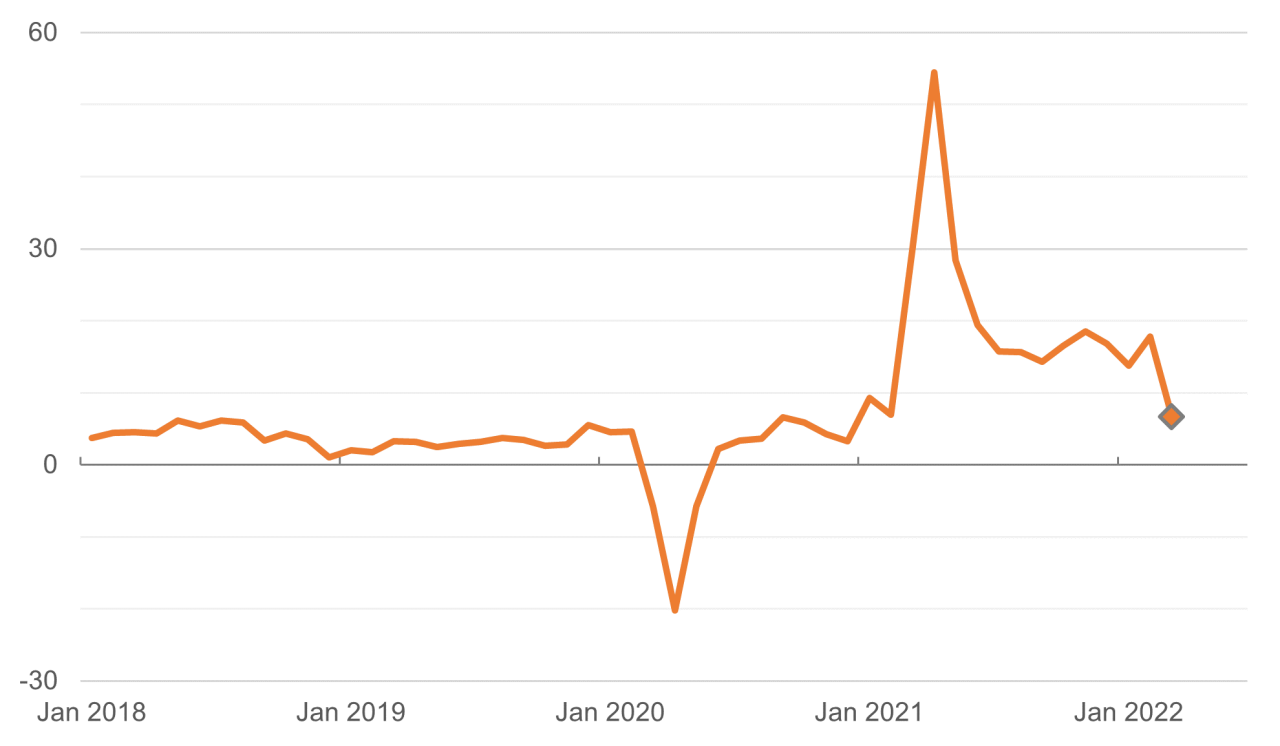
Data as of March 31, 2022. Sources: WTIA, U.S. Census Bureau.
Easing at the ports
Unprecedented retail spending and low labor supply drove shipping costs to astronomical new highs (Figure 4). The cost to ship a container increased more than six-fold from the eve of the pandemic to its peak in September 2021. Readers likely remember seeing photos of the massive traffic jams of boats anchored outside ports waiting for the chance to have their cargo unloaded. Those traffic jams have dissipated, the wait times have collapsed, and most importantly, the shipping costs have dropped sharply. The 25% decline through April 28, 2022, is indicative of a rapidly improving situation and will also ease costs for firms. We acknowledge the price is still very high relative to pre COVID, but inflation is a rate-of-change, and these declines will help.
Figure 4: World Container Index ($ per 40 ft. container)
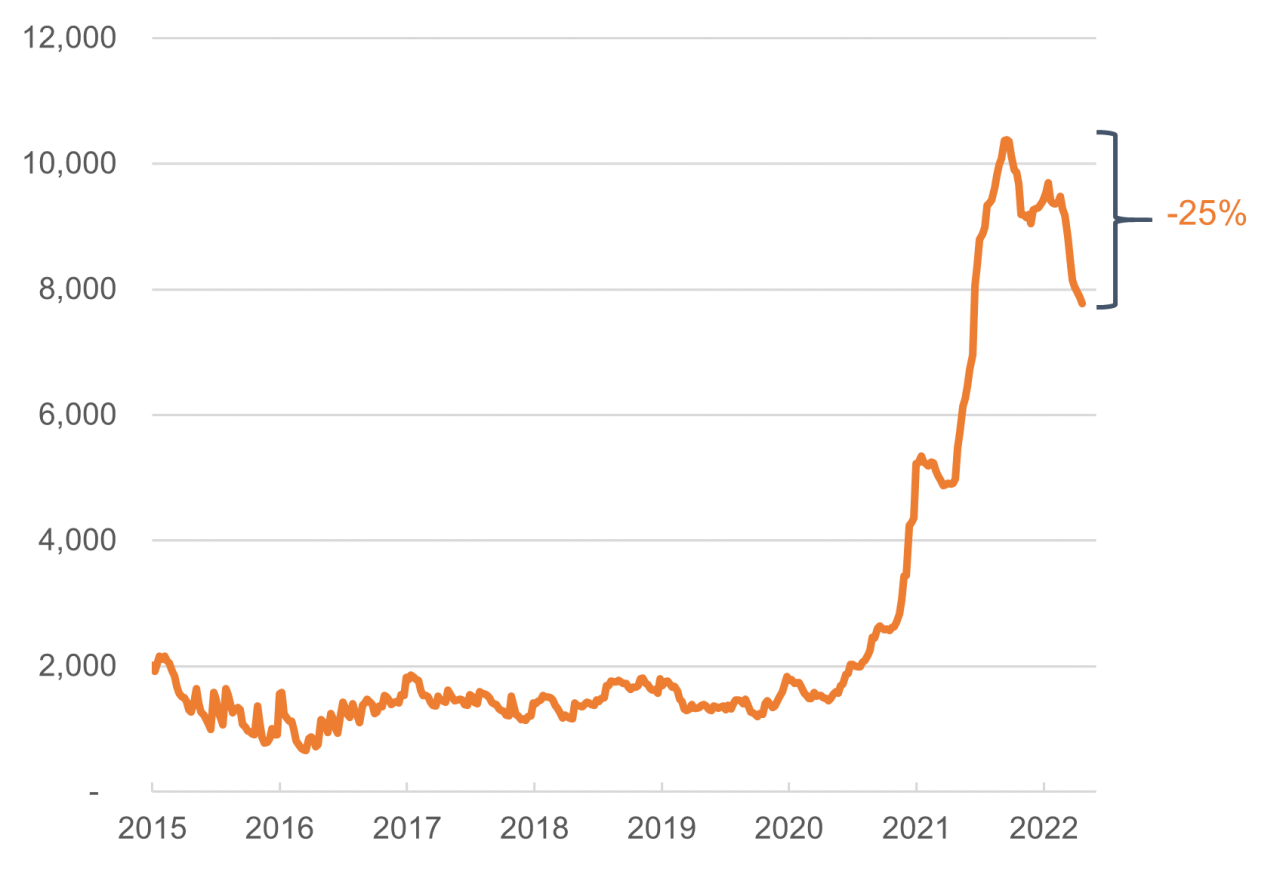
Data as of April 28, 2022. Sources: Drewry, Wilmington Trust.
Encouraging slowdown in wages but risks remain
The current state of the labor market cuts both ways, presenting optimistic signals for inflation, but plenty of reasons not to be too sanguine. At the end of 2021 there were about 2.5 million less people participating in the labor market compared to pre COVID. That “Great Resignation” as it was dubbed, included permanent retirees as well as people who were likely to return to work at some point. Those kept out by fears of the virus or were happy to get by on savings were always more likely to jump back in, and we’re seeing that in 2022.
More than 2 million have returned just this year, many after the Omicron wave subsided. At the same time, we’re beginning to see companies reduce their demand for labor in the form of reduced total job openings. Lower demand for workers combined with increased supply has taken some pressure off wages. Figure 5 shows that average wage growth over the past three months is still above a pre COVID average, but in March the figure registered the lowest gain since mid-2021. The improvement has been more dramatic for the leisure & hospitality sector, the proverbial “poster child” of the labor shortage. Wage gains in that sector have fallen from a peak of 23% annualized in mid-2021 to 8% in March.
The recent release of the Employment Cost Index (ECI), a broader measure of employee compensation, showed the fastest-ever increase in 1Q 2022. Much of that was not in direct wages and salaries, but in employee benefits as firms scramble for ways to attract and keep employees. The boost in benefits could be one-time bump but could also signal ongoing high costs outside of wages. We expect wage deceleration to continue, but recognize firms are still challenged and conditions might not normalize for some time, posing an upside risk for inflation.
Figure 5: Average hourly earnings (3-month annualized percent change)
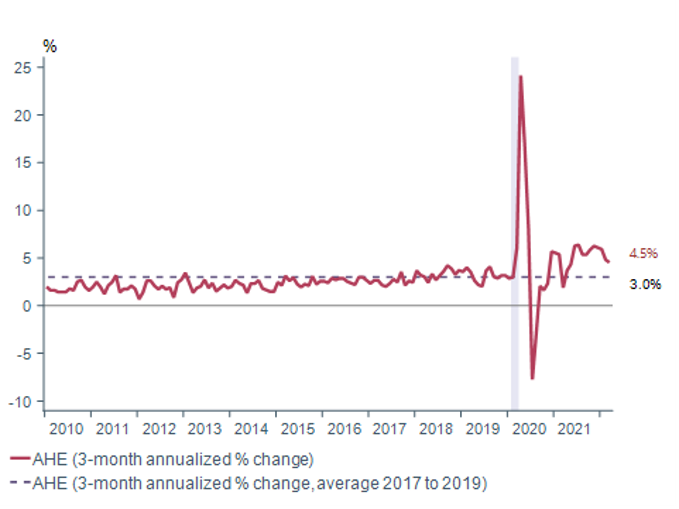
Data as of March 31, 2022. Sources: Macrobond, Bureau of Labor Statistics.
Home prices set to slow
The cost of having a roof over your head is, for most people, the largest expense and is therefore the largest single item in the CPI at 33% of the basket. The recent surge in home prices drove that “shelter” component of inflation to 5% y/y in March 2022, the highest level since 1991. Prices surged due to low supply, strong demand from former city dwellers, and very low interest rates. But Fed communications have pushed mortgage rates up at a pace not experienced since 1981, increasing by 1.9% in the 19 weeks since the pivotal meeting in December 2021. The national average for a 30-year mortgage is now above 5%, the highest level since 2010.
Housing usually has significant momentum, reacting slowly and with a lag to changes in the market. But the sharpness of this move is already being felt. The National Homebuilder Sentiment Index has fallen sharply since the start of the year with foot traffic of interested buyers diving along with expected future sales. Mortgage applications and pending home sales have plummeted and permit applications to build single-family homes are down. The most recent price data have not yet reflected the impacts but we expect they will in coming months and bring relief to this important component of inflation.
Figure 6: Home prices and mortgage rates
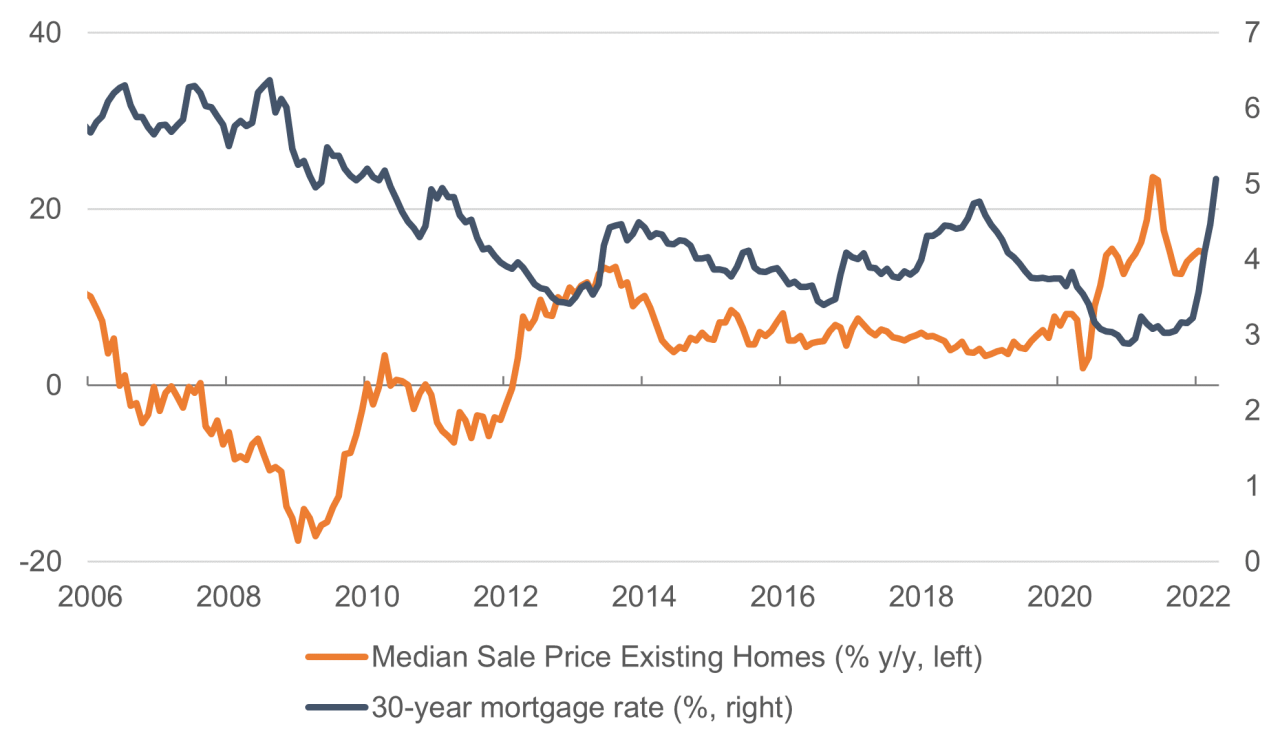
Data as of: April 29, 2022 for mortgage rate, February 28, 2022 for home price.
Sources: Bankrate.com, National Assn. of REALTORS, Wilmington Trust.
Upside risks emanating from Ukraine and China
We would have much more confidence in our expectation that inflation normalize this year were it not for new exogenous shocks from Russia’s war on Ukraine and China’s zero-COVID policy. As has been well-documented, Russia—the world’s third-largest oil producer—is posing a risk to future supply. Additionally, Russia and Ukraine combined produce a large share of several industrial metals as well as agricultural commodities and fertilizer. The ongoing war could push commodities higher once again.
Somewhat ironically, the decision by China’s leadership to lock down major cities is helping to keep oil prices from moving higher by suppressing demand. But those same decisions pose risks for supply chains of manufactured goods and also for shipping.
Before the war and lockdowns, the commodity cycle had been progressing in a quite familiar way. Figure 7 shows that commodity prices (raw materials) are extremely volatile. The recent experience has had stronger gains than normal as might be expected given the supply shocks and global stimulus. But in a year-over-year sense, the cycle was rolling over and starting to be reflected in decelerating producer prices for finished goods. Statistical analysis shows that prices of raw materials lead changes in those intermediate prices. They, in turn, lead the prices for consumers.
The unique feature of this cycle has been the continued acceleration in prices for those consumer goods, which had not rolled over on the far right of the chart. As described above, consumers were willing and able to shoulder more of those costs being passed through thanks to strong appetite and stimulus. We expected that to slow in coming months. Now with renewed risk coming from Ukraine and China the path forward is far less certain.
Figure 7: Commodity price flow through to consumer prices (% y/y)
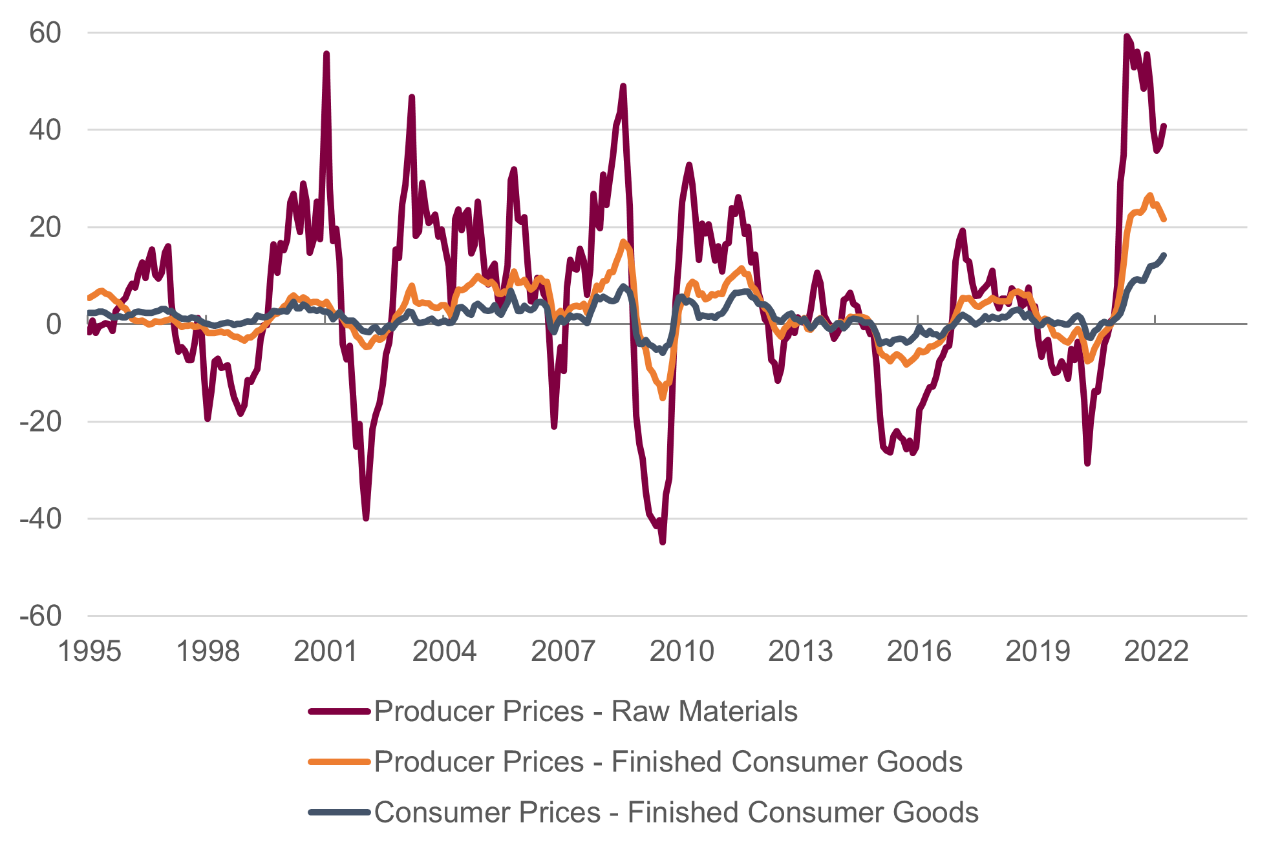
Data as of March 31, 2022. Sources: Bureau of Labor Statistics, Wilmington Trust.
Core narrative
Inflation is the main risk to the economic recovery as it weakens consumer confidence and has pushed the Fed to a more aggressive tightening cycle. But we see the weight of evidence pointing to a slowing of inflation even before the Fed started its tightening cycle. We expect a 0.5% hike at the upcoming May 4 meeting and another hike in mid-June of either 0.25% or 0.5%. The expectation of those hikes has already been priced in and may likely push down harder on inflation, especially through housing. We expect slower inflation and slower economic growth to lead the Fed to dial back rate hikes later in the year. The Fed’s aggressiveness has played a significant role in the poor performance of equities in 2022 thus far and dialing back some of that hawkishness could, by itself, provide support for equity performance. But the outlook for inflation and the Fed response has been clouded by uncertainties emanating from Ukraine and China. The uncertainty argues for caution in portfolios. In March we reduced our exposure to U.S. domestic equities to neutral relative to our benchmarks. We maintain a slight overweight to emerging market equities and an underweight to core fixed income.
Disclosures
Facts and views presented in this report have not been reviewed by, and may not reflect information known to, professionals in other business areas of Wilmington Trust or M&T Bank who may provide or seek to provide financial services to entities referred to in this report. M&T Bank and Wilmington Trust have established information barriers between their various business groups. As a result, M&T Bank and Wilmington Trust do not disclose certain client relationships with, or compensation received from, such entities in their reports.
The information on Wilmington Wire has been obtained from sources believed to be reliable, but its accuracy and completeness are not guaranteed. The opinions, estimates, and projections constitute the judgment of Wilmington Trust and are subject to change without notice. This commentary is for informational purposes only and is not intended as an offer or solicitation for the sale of any financial product or service or a recommendation or determination that any investment strategy is suitable for a specific investor. Investors should seek financial advice regarding the suitability of any investment strategy based on the investor’s objectives, financial situation, and particular needs. Diversification does not ensure a profit or guarantee against a loss. There is no assurance that any investment strategy will succeed.
Past performance cannot guarantee future results. Investing involves risk and you may incur a profit or a loss.
Indexes are not available for direct investment.
Reference to the company names mentioned in this blog is merely for explaining the market view and should not be construed as investment advice or investment recommendations of those companies. Third party trademarks and brands are the property of their respective owners.
Stay Informed
Subscribe
Ideas, analysis, and perspectives to help you make your next move with confidence.
What can we help you with today